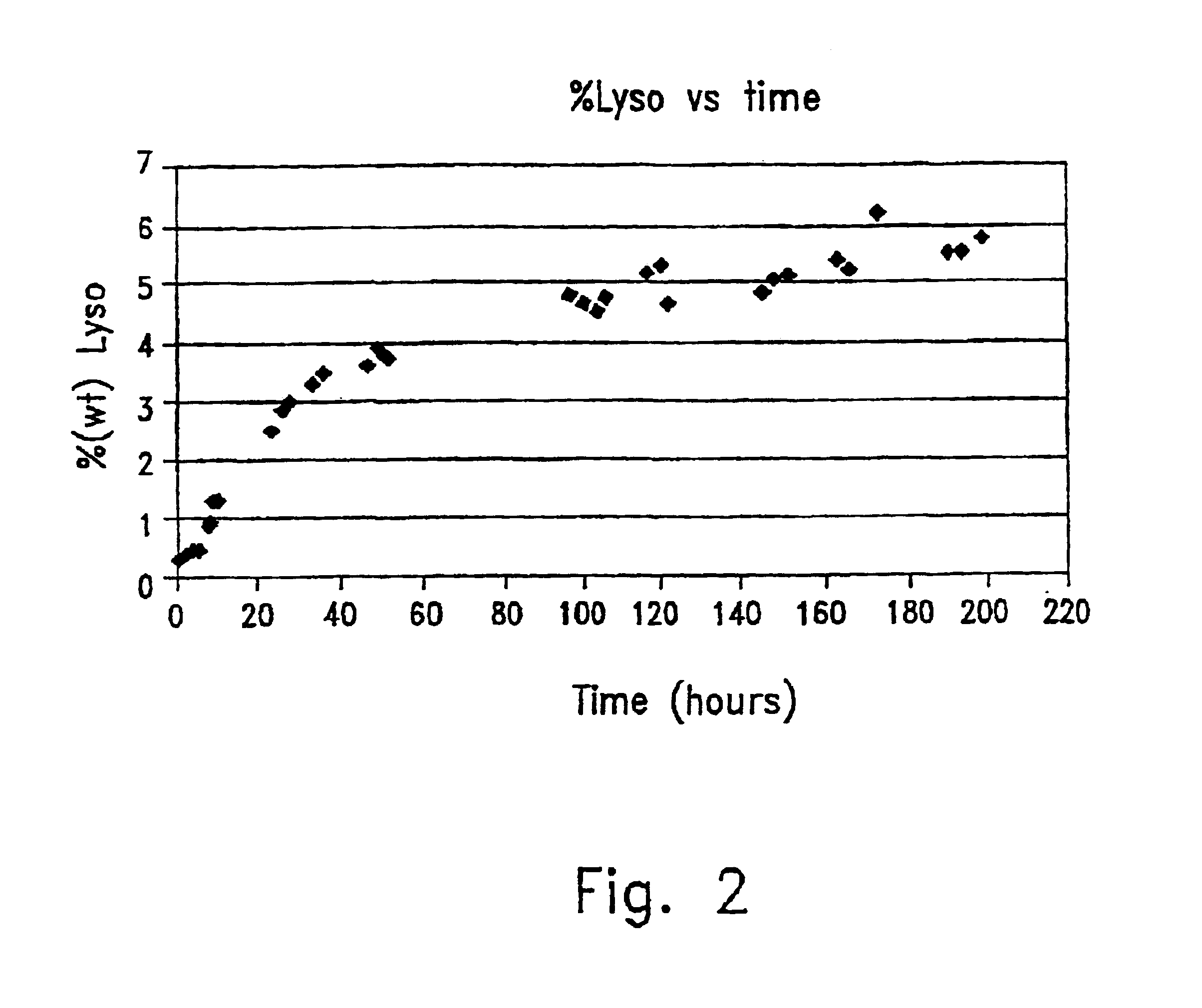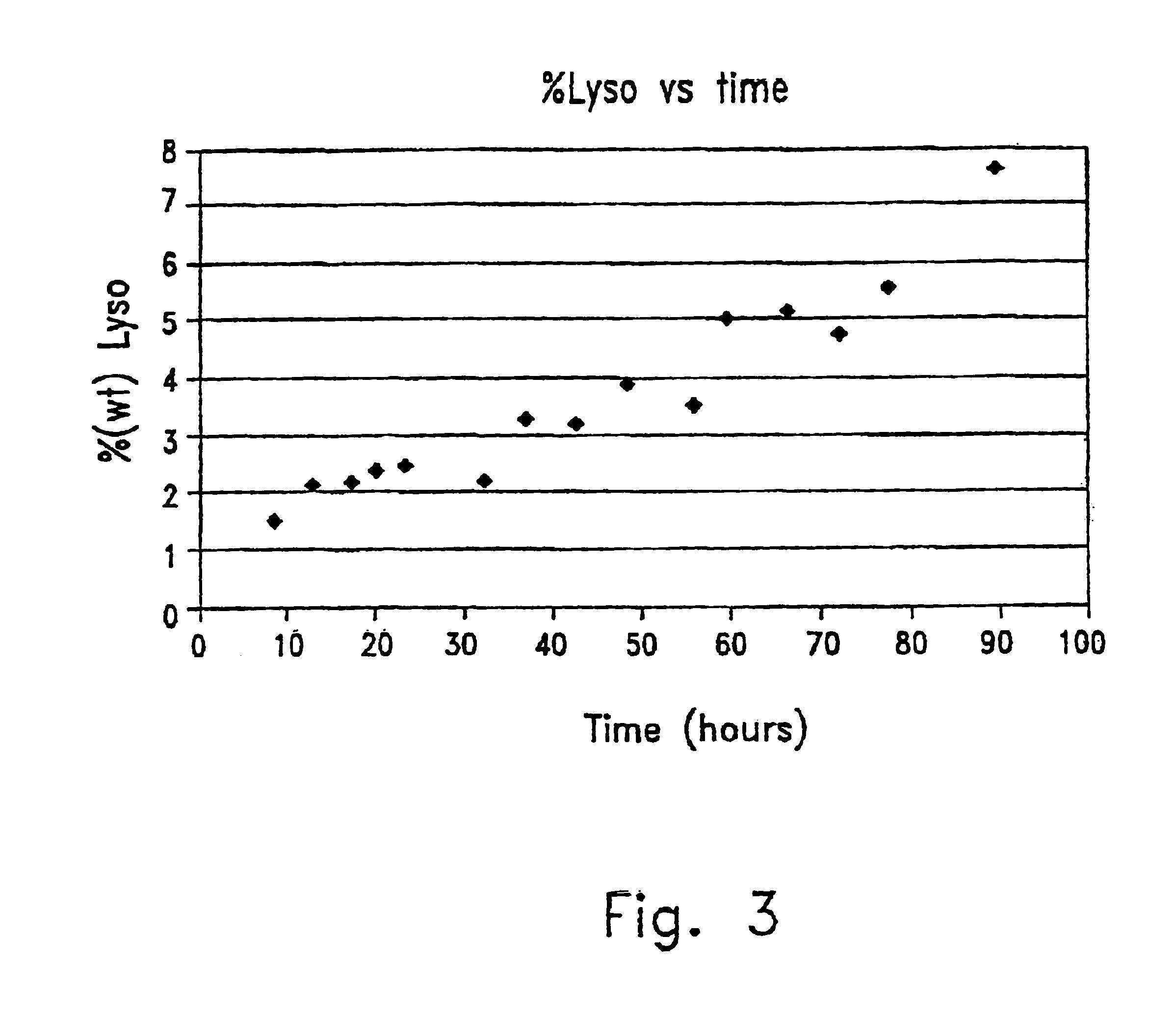Process for the production of phospholipids
a technology of phospholipids and phospholipids, which is applied in the field of process for the production of phospholipids, can solve the problems of slow formation of phosphatidylcholine, harm to the chiral center of natural phospholipids, and inefficient preparation of phospholipids having highly unsaturated fatty acyl groups, etc., and achieves high yield and purity.
- Summary
- Abstract
- Description
- Claims
- Application Information
AI Technical Summary
Benefits of technology
Problems solved by technology
Method used
Image
Examples
example 1
Preparation of 1,2-diacylated Glycerophospholipids Containing Fatty Acyl Groups at the sn-1 and sn-2 Positions
[0059]This example relates to the preparation of 1,2-diacyl-glycerophosphlipids, using different preparations of phospholipase A1 (Lecitase, Sankyo, Japan), referred herein to as PLA1,2, (or “the enzyme”) in a solvent-free system.
[0060](A). 50 mg enzyme preparation obtained from the genus Aspergillus, the strain SANK 11870 (or from other strains of the same micro-organism, as described in U.S. Pat. No. 5,538,874, Sankyo-Japan) were added to a mixture of 10 mg GPC, 5-10 μl water and 0.5 ml vinyl laurate. The reaction system was shaken at 60° C. Samples were withdrawn periodically, diluted appropriately, filtered and analyzed by HPLC.
[0061]Table 2 demonstrates the yield (in terms of percent area ratio) of the products obtained, 1-mono-lauroyl glycerophosphatidylcholine and 1,2-di-lauroyl glycerophosphatidylcholine, using different preparations of phospholipase A1 (Lecitase, Sa...
example 2
Preparation of 1-acylated-2-lyso-glycerophospholipids Using Lecitase® (Sankyo) Having PLA1,2 Activity.
[0081]It was found that the same Lecitase of Sankyo (PLA1,2) that in the absence of a solvent catalyzes the production of 1,2-diacyl-glycerophospholipids is capable, in the presence of an organic solvent, such as tert.-butanol, to catalyze the production of 1-acyl-2-lyso-glycerophosphlipids. Much less 1,2-diacylglycerophosphlipid is formed in the presence of tert.-butanol compared to the same reaction but when no solvent is present.
(A) The Preparation of Modified-immobilized Lecitase® (PLA1,2; Referred to as “the Enzyme”) Complex
[0082]The enzyme was dissolved in a phosphate buffer (such as, for example, K2HPO4 and KH2PO4, pH=5). Duolite A568 (or Amberlite XAD 7) was washed with de-ionized water several times (3-7 times). The dissolved enzyme was added to the washed Duolite A568 (or Amberlite XAD 7) and the formed suspension was vigorously stirred for 4 hours. After 4 hours SMO, eith...
example 2.1
[0088]The reaction was performed in 1 l Jacketed reactor with a stirrer at 60° C., for 200 hours.
[0089]The reaction mixture contained:[0090]0.0288 Kg GPC[0091]0.45 Kg vinyl stearate (VS)[0092]0.0225 Kg immobilized-modified enzyme complex[0093]0.15 lit t-BuOH
[0094]The VS was mixed with the t-BuOH to obtain a clear solution, the immobilized enzyme complex and the GPC were added when the solution was at 60° C.
[0095]The rate of conversion was 67%.
[0096]The kinetic curve of the production of 1-stearoyl-2-lyso-PC is described in FIG. 2.
PUM
 Login to View More
Login to View More Abstract
Description
Claims
Application Information
 Login to View More
Login to View More - R&D
- Intellectual Property
- Life Sciences
- Materials
- Tech Scout
- Unparalleled Data Quality
- Higher Quality Content
- 60% Fewer Hallucinations
Browse by: Latest US Patents, China's latest patents, Technical Efficacy Thesaurus, Application Domain, Technology Topic, Popular Technical Reports.
© 2025 PatSnap. All rights reserved.Legal|Privacy policy|Modern Slavery Act Transparency Statement|Sitemap|About US| Contact US: help@patsnap.com



